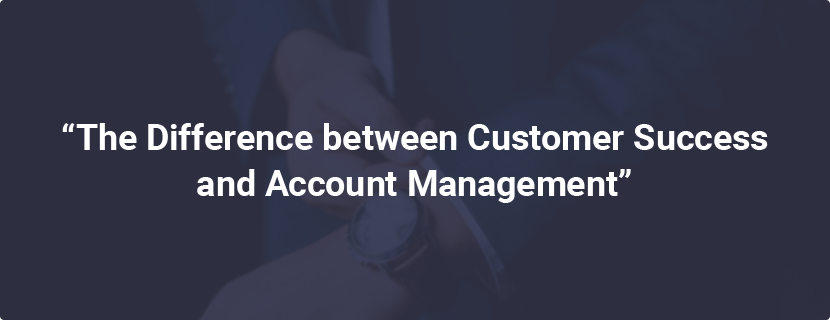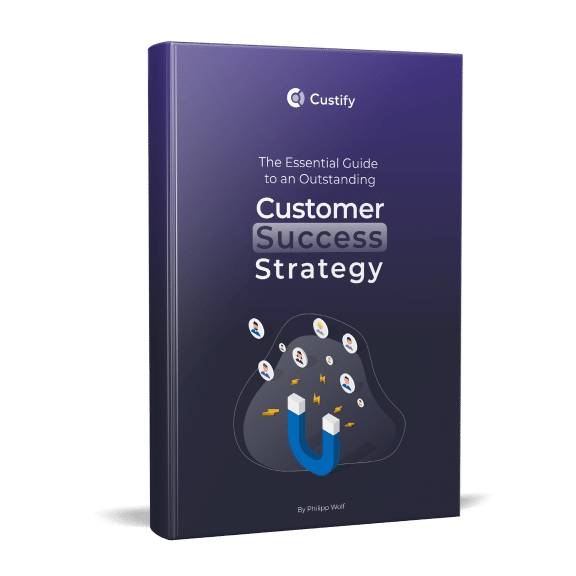Customer success managers and account managers are not the same job, nor are they two sides of the same coin. And if you want to run an efficient customer success team/program, you need to understand where the differences are
First off, it’s not enough to rename your account management department into a customer success one - that’s not going to accomplish anything. You’re only going to confuse those who don’t know what customer success is.
Instead, you can try to understand the key differences and pass that on to your team. In the next part, we’ll go over the five core areas where customer success management and account management differ.

1. Different Backgrounds
Account management has been around for a long time—companies long ago realized the importance of having a group outside of the sales team that focuses on renewing, upselling, and cross-selling. Account managers are present in all sorts of businesses, from traditional manufacturing to the most cutting-edge tech companies.
Customer success, however, is a bit newer. And its recent popularity has been driven largely by the software-as-a-service (SaaS) industry. While every industry can benefit from customer success strategies, the responsibilities of a customer success professional have largely been shaped by the SaaS customer lifecycle.
The backgrounds of these two fields might not seem relevant to the discussion of what they do differently. But how companies interact with customers has changed a great deal as business has changed, and that’s had an effect on what you need to do to generate customer loyalty.
Keep these different backgrounds in mind as you read on, and you may better understand why these two fields are as different as they are.
2. Main Goals
Customer success managers seek to help their clients succeed in their business goals. Account managers aim to get renewals, upsells, and cross-sells.
In the end, both groups have the same underlying goal: to keep revenue coming into their company. And it seems like their goals are one and the same—satisfied, successful customers are more likely to spend more money, aren’t they?
Yes. However, the metrics that are applied to customer success managers and those applied to account managers are often very different. And that results in different priorities. Account managers, for example, are often tasked with chalking up as many renewals and upsells as possible. They might have a sales quota.
Customer success managers, on the other hand, usually have success metrics that are tied to those of their customers. They might be measured by the ROI that their customers achieve using the company’s product or service. Or they could be tasked with raising Net Promoter Scores, which require that customers have a great experience with the product or service in question.
These goals are strongly linked to each customer’s lifetime value. Developing strong customer loyalty is at the core of customer success, and loyal customers are the most valuable to any company. Customers that have had great onboarding, adoption, and expansion experiences are likely to refer other customers, and that further increases their lifetime value. Increasing that value is of prime concern to customer success managers.
Again, both of these types of goals serve the same underlying purpose: to retain customers and generate revenue. But by relying on different metrics, the two schools of thought differ in a surprisingly significant way.
Because customer success metrics are tried directly to the numbers achieved by the customer, it encourages proactive, relationship-driven strategies that make for a very different style of management.
These goals influence the rest of the points on this list, especially this next one:
3. Proactive vs. Reactive
The proactive/reactive distinction is one that comes up a lot in discussions of customer success management vs. account management. And it’s an important one, even if it depends largely on the specific manager in question.
Because customer success teams need to anticipate their clients’ problems, they need to be in close contact. They need to proactively reach out to the clients, find out how they’re doing, and help them find the ways to get the highest ROI out of the product or service. They also need to have a deep understanding of the customer’s industry, issues, and goals.
This type of active relationship-building is what creates connections that drive customer loyalty. And this can be easily done by using a customer success platform that segments your customers so you know what to focus on.
Account managers, on the other hand, are generally reactive.
It’s worth pointing out here that active relationship-building is often a part of the account manager’s repertoire. We’re not suggesting that they sit back and wait for customers to come to them.
The actions they take related to their specific goals, however, are generally in response to requests from customers or based on a renewal timeline.
This is a key difference in how these types of professional differ on a day-to-day basis, and is part of the reason for their differing involvement throughout the customer lifecycle, as we’ll see in the next point.
4. Involvement Timeline
Most of the actions taken by account managers happen near the end of the customer lifecycle. Renewal, upselling, and cross-selling don’t usually happen until a customer is already a steady source of income.
Account managers might get involved near the beginning of the process as well, but most of their interactions with the customer are likely to be later.
Customer success managers, in contrast, are often involved through a larger portion of the customer lifecycle. They might be involved in implementation, helping customers set up a software solution or put a product into use.
If you’re using a customer success platform, it can notify you about different opportunities at the best time.
They’ll also help the customer onboard their employees or their own clients, help with training, provide assistance in expanding the customer’s use of the product or service, and so on. This is one of the reasons why customer success managers often have a smaller group of clients than account managers.
The necessity of long-term involvement also means that customer success managers have different needs:
5. Resources and Training
Because a customer success manager is involved in a wider range of activities through the customer lifecycle, they have many more resources at their disposal. For example, if an account manager receives a request for training on a product or service, they’d refer that request to another team.
A customer success professional, on the other hand, would do the training themselves. From implementation and onboarding to expansion and renewal, customer success managers help solve customer problems. And that means they need a wider skill set and access to more resources.
Despite the many emerging customer success courses & certifications, much of the knowledge is still gained on the job. That still means professionals need to have a deep understanding, not only of their own product or service, but also of their customer, how they use it, and how it can help them succeed in their field. They also need to be in close contact with other teams so they can get help fast if they need it.
Again, this is why customer success managers often have a much smaller client pool than account managers.
Account managers’ resources and training are often focused on sales. They help their customers solve problems, but they do so in an effort to move toward a renewal or upsell.
You’re probably noticing that many of the points we’ve discussed so far are related. That’s by design: customer success and account management have very similar goals. But their goals and methods, as we’ve stated, are different.
Customer success managers often act more like consultants than account managers—they get data from the customer, analyze their needs, and recommend effective ways to move forward. They also have a very deep understanding of their client’s market, exceptional product knowledge, and a firm grasp on how their product helps customers succeed in their particular position. Developing this level of expertise is time-consuming, but it’s what enables customer success agents give their clients more than cursory advice.
This consultative relationship is what helps them build strong connections to their clients, and ultimately increase the customer’s lifetime value.
Customer Success and Account Management: Separate, But Complementary
These two fields are inherently different, even though they end up serving the same goal in the end. Their immediate goals, however, and their methods for pursuing those goals, are distinct.
That’s why they should be kept separate. Renaming account managers as customer success managers isn’t going to help you be more focused on customer success. You need to implement an entirely new position with a new work and team structure.
That doesn’t mean that customer success managers and account managers shouldn’t work together. In fact, they should be in close contact throughout much of the customer lifecycle. A successful customer success manager will make an account manager’s job easier, because the customer will be happy with their service.
Creating the kind of long-term relationship that a customer success manager seeks is crucial to generating customer loyalty and driving renewals (and, therefore, revenue). Some customer success managers will be closely involved in account management, but others will defer to account managers when it’s time to upsell and get renewals. It just depends on how your company is structured.
But the two aren’t exclusive—they can both be active and successful in a single company. The crucial thing to remember is not to conflate them. A customer success manager isn’t an account manager with a new title.
Are you ready to delight your customers? Check out the benefits of using a customer success platform and schedule your Custify demo now.




